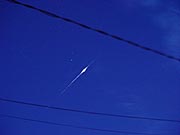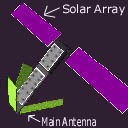

IRIDIUM FLARES What they are and how to see these astronomical fireworks from your back yard!

Here's
what IR satellite number 34 looked like from my backyard
when
it flared on the evening of 18 September, 2004. It was
much
brighter and longer-lived than any meteor I've seen
The Iridium satellite system consists of 66 active satellites, and a dozen inactive spares, that circle the Earth in low orbits. They are used to support a system of industrial and business-class cell phones that connect any Iridium phone in the world to any other regardless of location. The satellite coverage is so complete that there are no dead zones where you can't send or receive a signal. The system is called "Iridium" because the element iridium has the same atomic number as the number of satellites in the system. (The home page for the Iridium system is http://www.iridium.com.)
Each Iridium satellite is equipped with three polished aluminum antennas that are extremely efficient reflectors of sunlight.

When in the proper orientation the sun shines off of one of the antennas and down to Earth. Because the orbital paths and orientations of the satellites are well known, it's possible to predict where the reflection will strike the Earth. If you are standing in one such location and happen to be looking up toward the satellite, you will see a faint star-like point of moving light suddenly explode into a brilliant flare. Such flares can be 30 times brighter than the planet Venus, which, other than the moon and the sun, is the brightest object in the sky. How bright the flare appears depends on where you are standing relative to the center of the reflection. Fortunately, finding out when and where to look to see an Iridium flare only takes a moment by visiting a website that predicts when and where these flashes occur. Because there are so many satellites in the Iridium system and each has three reflecting antennas, flares are very common. In a typical week the average back yard in the USA can expect to witness half a dozen or more of them, usually in the early morning or early evening hours. These flares can be so bright that they can even be seen in daylight.
The flares last anywhere from 5 to 20 seconds but you'll be able to spot the satellite before the flare and follow it long after the flare so the total viewing experience can last up to a minute. The brightness of the brightest flares can be astounding. I've witnessed one that was so bright that it caste strong shadows. I could read a newspaper by its light.
So, how do you see an Iridium flare? It's easy.
Log onto the satellite prediction website http://www.heavens-above.com. Scroll down the page until you get the the "Register" options. While there are several options, the one I found easiest to use was to click on the "Select" word link under the "Anonymous" category. Select your country from the list that comes up then type the name of your city in the "Search" block. If your city is listed it will come up with other similarly named cities. Click on the one that's yours. You will be sent to the prediction page for your city. Save this page in your "Favorites" file and then any time you want to see if there are any Iridium flares open it from your "Favorites" list and you won't have to repeat the login process.
Once you are on the predictions page scroll down until you see the paragraph titled Iridium Flares and click on the "next 7 days" link. You will be give a list of the dates, times, brightness, and positions in the sky in which you'll be able to see Iridium flares in the coming week.
The brightness is indicated by an astronomical brightness system. In this system the brighter an object is the larger it's negative number will be. For example, an Iridium flare that has a brightness of -8 is brighter than one that has a brightness of -7.
The listing also tells you where to drive to position yourself in the middle of the flare's reflected beam so that it appears it's brightest. Many times a short drive of a few miles will increase the brightness by a factor of 100 or more.
Once you've found an Iridium flare you want to see, the second thing you have to do is set your watch to accurate time. (This is necessary because Iridium flares are over so quickly that unless you know when to look for them within a few seconds you can miss them.) To do this scroll down the prediction page to the "Miscellaneous" listing and click on the "What Time Is It" link. This will put you onto a page which provides the accurate time for your area. (Note that the time will be given in 24-hour format so that 1500 hours means 3 in the afternoon.) Set your watch to this time, being sure to adjust for any time lost during the setting and you're good to go.
That's it! Enjoy!
Note: Satellite watching is an interesting hobby. The Heavens Above page also provides information for spotting many of the satellites currently orbiting the earth.
Return to my main
page to view 70 other topics:
everything from metal detectors to the strange world of lucid dreaming.